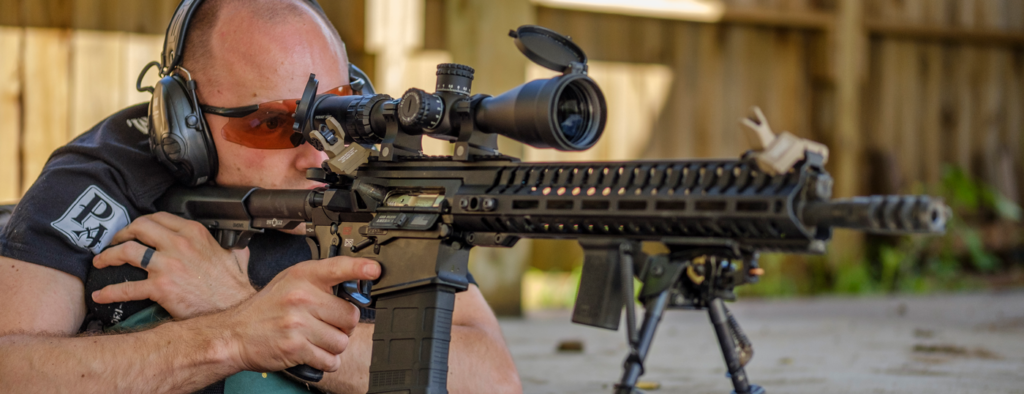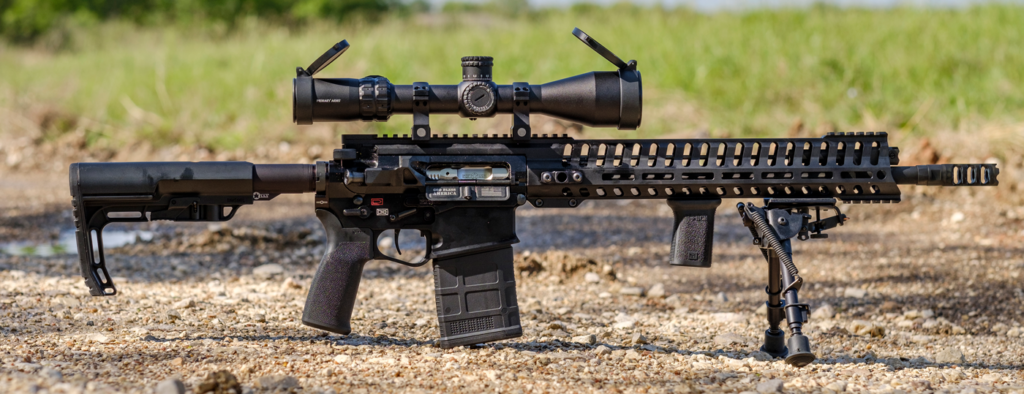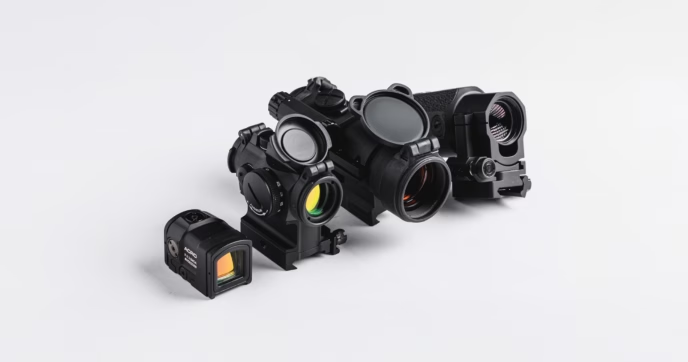Primary Arms is proud of our reputation, and we work hard to protect it. Our scopes must be tough, dependable, bring the features our customers really want, and priced right. We like upsetting the competition. We want our $150 red dots to compete well against their $300 red dots. We want our $1500 Platinum scopes to compete well against their $2500 precision optics. That’s our game. After a long wait, we’ve just stepped our game up again. Meet the new Primary Arms 3-18×50 First Focal Plane Scope, now available with the exclusive, patented ACSS HUD DMR .308 and HUD DMR 5.56 reticles, for $499 with our no-nonsense Lifetime Warranty. You haven’t seen it yet, but we have. Here’s everything you need to know.
Pay Attention and Focus – Adjustable Diopter Ring
An adjustable diopter ring out back controls the focus of the reticle as seen by your eyes. It’s the first thing we want people to read about in the user manual, so let’s cover it first here too. If the diopter ring is set wrong for your eyes, nothing else matters; you’ll hate using your scope and you’ll miss the target too. With the scope pointing at a blank background like a white wall or a clear blue sky, you’ll want to play with that diopter ring until the reticle is sharp and crisp. If you wear prescription glasses or contacts when shooting, you’ll want to wear them when you set the diopter ring too. Everyone’s eyes are different, so ideal diopter ring settings are different for each shooter as well. Once you have the reticle sharp and crisp, most folks just rely on tension from the rear flip cap to hold it in place. Some shooters will wrap a piece of electrical tape around the ring to help prevent accidental movement. Others put a dab of paint or fingernail polish on the ring and an adjacent dab on the scope body, so they can easily check the diopter ring alignment at any time.

Counting Clicks – Windage and Elevation Adjustment
The Primary Arms 3-18×50 is an all-new scope design. It uses some of the most popular features from our top-of-the-line Platinum scopes, like locking adjustment knobs. When the adjustment knobs are pressed down towards the scope tube, they can’t be turned. That means no “accidental clicks” as the scope gets bumped around, dropped or jostled. Simply pull the knobs outwards to adjust, then push them back in to lock. After you’ve sighted your rifle in you can use a coin to undo a center screw and reset the knobs to read “0” as your baseline for counting click adjustments later. Those clicks are audible and tactile, and consistent. They are set to move your point of impact only 0.1 MIL / MRAD per click, or .36 of an inch at 100 yards. These are fine adjustments—if your group is 2.5 inches away from the X-ring, it’ll take 7 clicks to correct that distance. Total adjustment range is 50 MOA or 14.54 MIL, giving you roughly 145 of those clicks to work with, so there’s no need to worry. But one of the best features about this scope isn’t how great the adjustment knobs are, but how seldom you’ll need to use them. More on that below!
Parallax Precision – Adjusting Parallax
The parallax adjustment knob is located on the left side of the scope, sharing a spot with the illumination knob. It is marked with ranges from 15 yards to infinity. Although it is often referred to as a “side focus” knob, parallax and focus aren’t the same thing. Parallax error occurs when the target’s image and the reticle are not aligned on the same focal plane inside the scope. To visualize this, pick a picture on the wall of a room as your “target” and stick your thumb up in front of it like you are a hitch-hiker. Your thumb represents the reticle of the scope. Closing one eye and using your thumb to “aim” at the picture on the wall, you’ll notice that moving your head around changes where your thumb appears to be aimed. That’s because your thumb is not located in the same focal plane as the picture on the wall. Any slight change in your head position will change your point of aim, and that means the consistency you need to take a precision shot is gone. Adjusting your parallax properly using the knob and you can eliminate parallax error by bringing the reticle into the same focal plane as the target, like having a friend place their thumb directly against the picture on the wall. Parallax is most important in high magnification, precision shooting applications. You won’t see an adjustable parallax on a 3x prism scope or a 1-6x low power variable scope. Those optics eliminate parallax at just one range (usually 100 yards) and aren’t intended for shooting with such precision or at such great distances that parallax error is going to really matter. But when your scope is set to 18x magnification and your target is beyond 1,000 yards, you better have a trustworthy parallax adjustment knob. Put a big checkmark in that box—we’ve handled it.
Seeing Red, Switching Views – Illumination and Magnification Control
Reticle illumination control is located on the left side of the scope along with parallax adjustment. Numbers 1 through 4 are useful for low light situations. Settings 5 and 6 are daylight bright, but the reticle is etched so it can be used without illumination as well. Only the center chevron and horseshoe illuminate, simplifying the illuminated sight picture at dawn and dusk, when seeing the target is most difficult.
The power ring controlling magnification features a removable “fin” that attaches using two small allen screws. The fin acts like a small throw lever to make magnification adjustments easy. Undo those screws to remove the fin and replace it anywhere you like on the power ring, which has mounting holes drilled all around it. You can place the fin anywhere that’s best for how you prefer to manipulate the power ring. Later on we plan on offering a couple of larger fin options for sale separately, so you can customize your scope with extra magnification cranking leverage.

Heads Up! –The ACSS HUD DMR Holdover Reticle
The brain of this scope is the patented, exclusive ACSS HUD DMR reticle. This reticle has proven effective in our 4-14×44 FFP scopes and our Platinum 6-30×56 FFP scopes, so we are confident it will be a winner in the 3-18×50 FFP scope as well. Follow a chart in the instruction manual to sight in your particular loading of .308 Winchester or .223 Remington. HUD DMR 308 works best with the heavier, slower moving .223 Remington loads in the 75 to 77 grain range, because their overall trajectory is extremely close to common .308 loadings. If you are planning on shooting 55 grain or 62 grain 5.56 NATO spec ammo, hold out a bit because this scope is coming in HUD DMR 5.56 soon. Both are used the same way, but have very slightly changed dimensions to account for different bullet trajectories.
At first glance, HUD DMR looks a bit like an angel with wings spread out to each side and a red halo. What the heck are all those lines and circles for? HUD DMR is a holdover reticle, which means after you carefully sight in your rifle, you will want to reset your turrets to zero, push them in to lock them, and then… leave them alone. The reticle will tell you what to do, and because of the scope’s first focal plane construction, the advanced features will work properly at ANY magnification.
Bullet drop compensation is a great example of the holdover concept. Say the scope is zeroed at 100 yards per the instruction manual, but the steel gong target is 500 yards away. Using a traditional crosshair, you’ll need to find your bullet’s drop at 500 yards using a ballistic calculator, convert it to milliradians (abbreviated MIL or MRAD), then count clicks to physically move the erector tube inside the scope until the crosshair is correctly adjusted to hit. If the bullet drop is 3 MILs for example, you would need to reach up and turn the elevation adjustment knob 30 clicks before taking the shot. If you wanted to shoot at 100 yards again you would have to count 30 clicks in the opposite direction to return to your zero position, or you would miss. Doing all this while tracking a moving target through the scope is awkward and time consuming at best. Don’t get confused and turn the wrong direction, or all is lost. The ACSS HUD DMR holdover system offers a better way. Hash marks underneath the center chevron provide aiming points of aim all the way out to 1000 yards, because we already did the math on how to compensate for the bullet’s drop at all those distances. To hit that 500-yard target, abandon using the center chevron aiming point and shift your aim upwards to the correct hash mark underneath. At 100 yards the bullet will sail high, but at 500 yards gravity will drag it back down right to where the target is. Ding!
Curve the Bullet – Wind Push
Bullet drop compensation is simple enough, but where HUD DMR starts to shine is in windy conditions. Understanding wind drift is very critical for precision long range shooting. Even a 2-mph wind at a 90-degree angle can push the bullet to drift over 10 inches at 600 yards, making the difference between a hit and a miss. With a crosshair you would have to “chase the wind” by doing more math and counting more clicks to adjust windage, or else make a “Kentucky windage” guess based on your experience. Acss HUD DMR provides wind hold dots for 5 and 10 mph winds to help you hold over with a proper aiming point out to 1000 yards. If the wind is blowing left to right at 10 mph as you prepare to engage your 500-yard gong, use the 10-mph dot to the right of center as your point of aim. Just hold that dot right on top of the target, pointing the rifle high and left. As the bullet drops on its way to the target, the wind will also push the bullet to the right. HUD DMR’s holdovers give you a precise point of aim to compensate for the bullet’s curving arc through the air, without doing math or touching the adjustment knobs. If the wind shifts direction or changes intensity, you won’t be caught with the wrong physical setting on your scope. Just change your holdover to match. You can also use the wind hold dots as a starting point to make even more intelligent decisions about where to hold. If you are only dealing with a little 2.5-mph breeze, for example, you would hold halfway between the center BDC and the first 5-mph wind dot. Easy!
Moving Right Along – Moving Target Leads
The hardest targets to hit at any kind of distance are “movers”. Whether it’s a hunting, tactical, or competition situation, the complex calculations required to estimate a correct point of aim for moving targets are really intimidating. Sharpshooters of the past who managed to score hits on moving targets needed years of shooting practice, great eyesight and instincts, and a bit of luck. With ACSS HUD DMR you merely need to estimate the target’s speed and use the correct moving target lead right there in the reticle. 3.1-mph (walk), 6.1-mph (jog or trot), and 8.6-mph (sprint) speeds are laid out. Shifting the point of aim ahead of the moving target’s direction of travel works like a quarterback throwing a football to a certain spot on the field, knowing his receiver will reach that same spot in time to make the catch. No other reticle does moving target leads like the ACSS HUD DMR. The hardest part is gauging how fast the target is moving. If you can do that, the reticle does the rest, all the way to 600 yards.
Lone Ranger – Automatic Range Estimation
Of course, you don’t stand a chance of hitting a long distance target if you can’t calculate how far that distance is with a reasonable degree of certainty. On a square range with targets at known distances, it’s not an issue. Out in the field, a laser rangefinder can be very helpful. But laser rangefinders have some well-known drawbacks and limitations. ACSS HUD DMR features advanced auto ranging abilities built right into the reticle. You can use the 8.6 mph moving target leads to range estimate a 10” target, use the vertical bars left and right of the horseshoe and chevron to range estimate 36” tall targets, and use the BDC hashmarks down the middle to range estimate targets 18” wide. For example, if you are hog hunting, try to fit the hog’s head (which measures roughly 10”) inside each of the 8.6 mph moving target lead circles. If the hog’s head fits best inside the second circle down, that hog is approximately 400 yards away. With that established, use the BDC and wind lead dots, or the moving target lead dots, to take a smart, precise shot without ever taking your eyes of the target or turning an adjustment knob.

Unbeatable Combination
We crunched all the math for these calibers. We tested the ACSS HUD DMR extensively in the windy Nevada desert. Primary Arms customers across the country have proven that it really works in two successful scopes already. Installing this reticle into our all-new Primary Arms 3-18×50 scope was an obvious move. We’ve created an unbeatable real-world combination. This flexible scope is fast to acquire the target at low magnifications and short ranges yet can dialed up to take long range shots on difficult targets in a variety of circumstances at medium to long range, even as the sun slips below the horizon. You get all this for $500 and it’s protected by the Primary Arms lifetime warranty. Unlike other lifetime warranties that only cover “manufacturer defect”, we don’t play word games. Our warranty covers normal wear and tear—if you just plain wear out your 3-18×50 scope from shooting it so much on your high-recoiling rifle, we will repair it or replace it. It’s the best $500 scope you haven’t seen yet, but you can buy yours with confidence. This one is a real winner, and it is worth waiting for.



